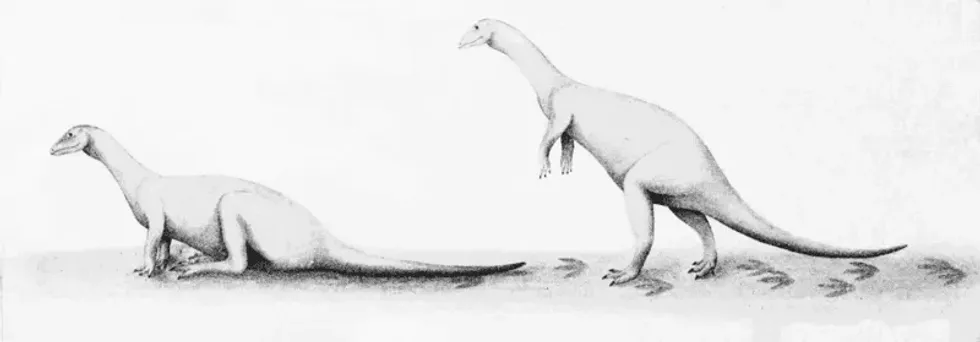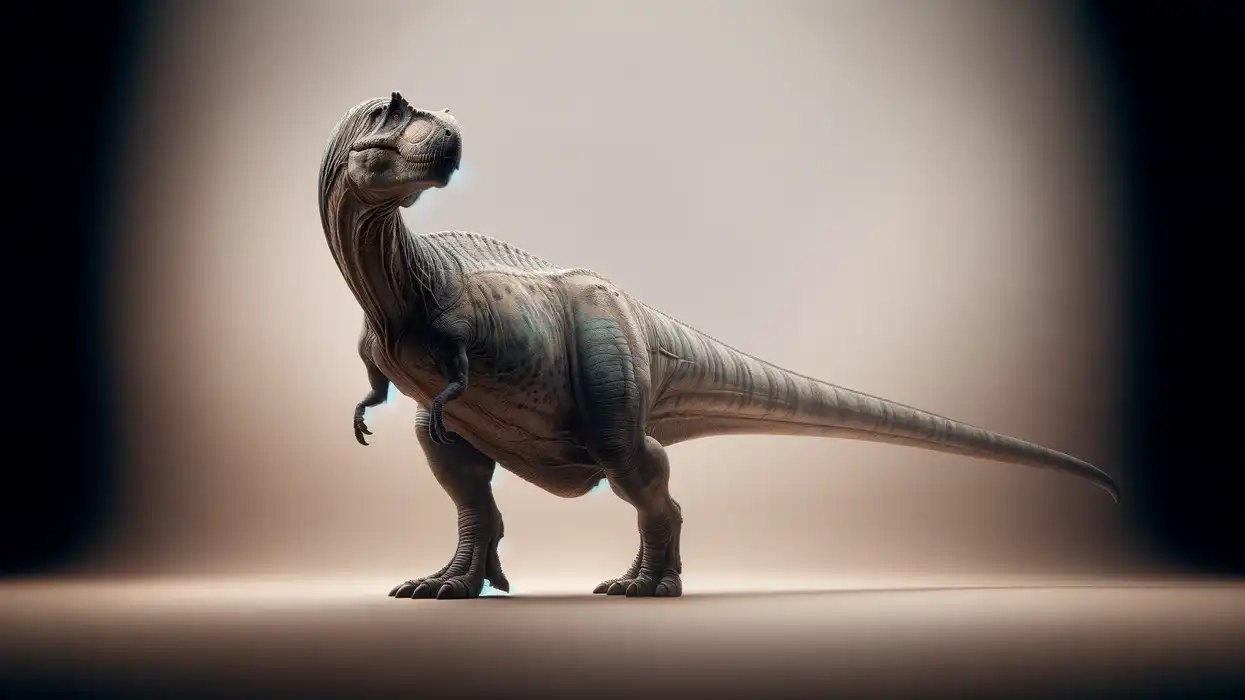The genus Sphaerotholus is a group of pachycephalosaurid dinosaurs in the clade Dinosauria. The dinosaur Sphaerotholus is known to be from the Maastrichtian age of the Upper Cretaceous period of the present-day western United States and Canada.
The pachycephalosaurid dinosaurs were known to be found in present-day North America. To date, three new species of the genus have been found, however, only fragments of the part of the skull has been found and not much more.
We can compare this genus to other similarly-sized pachycephalosaurids, like the dinosaur Prenocephale and dinosaur Stegoceras that are completely known at the moment. We will learn more about the species more in the later topics.
The name Sphaerotholus is actually a combination of the Greek word Sphaira which means 'ball' and the word tholos which means 'domes'. The name Sphaerotholus is in reference to the pachycephalosaurian skull shaped like domes.
This new genus of highly derived pachycephalosaurian from western North America (Journal of Vertebrate Paleontology, Williamson and Carr) existed in the earth around 83.6 million years ago to Maastrichtian Age in the desert habitat.
11 specimens have been found to date which helped in the formation of the type species.
Most distribution of the dome-shaped skull Dinosauria members are limited to Western North America and the classification has been done with respect to that distribution. Some scientists believe that this herbivorous dinosaur that lived between 70 million-65 million years ago could also have been a carnivore, but not much information is available to prove that fact.
The three species of the late cretaceous period are - S. goodwini (Kirtland Formation, Upper Campanian age), S. buchholtzae (Hell Creek Formation, Late Maastrichtian age and Frenchman Formation), and S. edmontonensis (Horseshoe Canyon Formation, Brown and Schlaikjer-1943). A skull has been kept safe of S. goodwini in the New Mexico Museum of Natural History.
For more relatable content, check out these Chungkingosaurus facts and Crichtonsaurus fun facts for kids.
Sphaerotholus Interesting Facts
How do you pronounce 'Sphaerotholus'?
The pronunciation of the name Sphaerotholus is 'Sphe-ro-tho-las'.
What type of dinosaur was a Sphaerotholus?
Sphaerotholus is a genus of pachycephalosaurid dinosaurs found in the Late Cretaceous period in the United States and Canada. The dinosaurs in this genus have domes as the shape of their heads and are similarly sized to dinosaur Prenocephale and dinosaur Stegoceras.
The dinosaur Prenocephale and dinosaur Stegoceras are completely known to us by now.
The classification of these dinosaurs shows three new species found in different forms and divided by the distribution - S. goodwini, S. buchholtzae, and S. edmontonensis. These pachycephalosaurid dinosaurs are part of the family Pachycephalosauridae of the clade Dinosauria.
Williamson and Carr first described the dinosaur genus of the family Pachycephalosauridae in 2002.
In which geological period did the Sphaerotholus roam the earth?
This genus of the Pachycephalosauridae family used to live on the planet in the Upper Cretaceous Period. The type species of this dome-shaped skull pachycephalosaurid dinosaur are all scattered throughout the Upper Campanian and Late Maastrichtian periods of the Late Cretaceous age.
When did the Sphaerotholus become extinct?
These pachycephalosaurid dinosaurs used to live around 70 million years ago to 65 million years ago in the Upper Cretaceous age.
Where did a Sphaerotholus live?
These pachycephalosaurid dinosaurs used to live in the western United States and Canada during the Late Cretaceous Period.
The classification shows that there are three species known for this fairly unknown dinosaur. S. goodwini was found in the Late Campanian period from the Dennazin Member of the Kirtland Formation in San Juan County, New Mexico, USA.
S. buchholtzae was found in the Late Maastrichtian period of the Upper Cretaceous age in the Hell Creek Formation of western Carter County, Montana, USA and Frenchman Formation of Saskatchewan, Canada. The last type species S. edmontonensis was found from the Horseshoe Canyon Formation of Alberta, Canada (Brown and Schlaikjer, 1943).
The Journal of Vertebrate Paleontology by Williamson and Carr sheds a lot of new data to this Pachycephalosauridae species.
What was a Sphaerotholus' habitat?
The dinosaur in this genus of the family Pachycephalosauridae in the Dinosauria clade was known to be terrestrial and lived in a desert environment.
Who did a Sphaerotholus live with?
No information is available on the company on this dome-skull dinosaur genus. Seeing the size of these dinosaurs, they probably lived in small groups. Even the images and sketches available of this dome-skull species show them in groups or pairs.
How long did a Sphaerotholus live?
This information is not available on these dinosaurs from the Pachycephalosauridae family.
How did they reproduce?
We know that these dinosaurs from the Late Campanian and Late Maastrichtian periods of the Upper Cretaceous age laid eggs for reproduction. The number of eggs is not known. Dinosaurs usually laid around three to five eggs at a time and the clutch size could go up to even 15-20.
Sphaerotholus Fun Facts
What did a Sphaerotholus look like?
 *We've been unable to source an image of Sphaerotholus and have used an image of Nanshiungosaurus instead. If you are able to provide us with a royalty-free image of Sphaerotholus, we would be happy to credit you. Please contact us at hello@kidadl.com.
*We've been unable to source an image of Sphaerotholus and have used an image of Nanshiungosaurus instead. If you are able to provide us with a royalty-free image of Sphaerotholus, we would be happy to credit you. Please contact us at hello@kidadl.com. We know the name Sphaerotholus is derived from the Greek word sphaira which means ball and tholos which means dome. This is in reference to the dome-shaped skull of the Pachycephalosauridae dinosaur.
As we do not have many details of the skeleton found of these dinosaurs, we can very well compare them to the Stegoceras and Prenocephale dinosaurs. The Stegoceras and Prenocephale dinosaurs are well known and similarly sized to the Sphaerotholus.
This dinosaur was earlier considered a synonym of Prenocephale by Sullivan.
But later, Longrich in 2010 and Schott and C. Evans in 2016 kept both as distinct genera of Pachycephalosauridae. All dinosaurs in the clade Dinosauria of this family have a stout body with a short, thick neck, short forelimbs, and tall hind legs, similar to Prenocephale, Stegoceras, and Sphaerotholus.
The fossil found of S. goodwini is kept at New Mexico Museum of Natural History. The species from New Mexico has an incomplete skull lacking the facial and palatal elements. Not much is known from the only the dome-shaped skull kept in the Museum of Natural History. But the differentiation from S. buchholtzae can be established from there.
The holotype of S. buchholtzae has an incomplete skull.
How many bones did a Sphaerotholus have?
The number of bones of this genus from the Upper Cretaceous Period is not known.
How did they communicate?
They probably communicated visually or vocally. Not much information is known.
How big was a Sphaerotholus?
The length and height of the dinosaurs are not known as only skulls have been found to date.
How fast could a Sphaerotholus move?
The speed is not known. Their small size would have made them agile.
How much did a Sphaerotholus weigh?
Their weight is not known.
What were the male and female names of the species?
There is no data to validate if males and females were given different names.
What would you call a baby Sphaerotholus?
This information is not available.
What did they eat?
They were considered herbivores. However, some scientists suggest they might have been omnivores.
How aggressive were they?
This data is not available.
Did you know...
They may be considered endemic as the fossils have only been found in western USA and Canada.
What is the sister taxon of Sphaerotholus?
Some consider S. goodwini as the sister taxon to the clade formed by S. edmontonensis and S. buchholtzae. No other information is available.
Was the Sphaerotholus a herbivore?
It is considered a herbivore by most, but some scientists have also considered the dinosaur to be an omnivore.
Here at Kidadl, we have carefully created lots of interesting family-friendly dinosaur facts for everyone to discover! Learn more about some other creatures from our Harpactognathus facts, or Puertasaurus facts for kids.
You can even occupy yourself at home by coloring in one of our free printable Sphaerotholus coloring pages.
**We've been unable to source an image of Sphaerotholus and have used a sketch of a herbivorous dinosaur instead. If you are able to provide us with a royalty-free image of Sphaerotholus, we would be happy to credit you. Please contact us at hello@kidadl.com.










